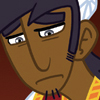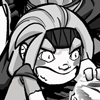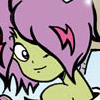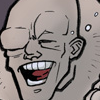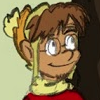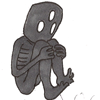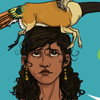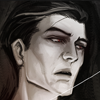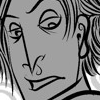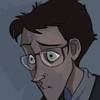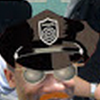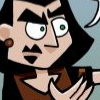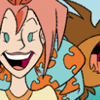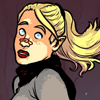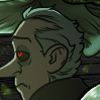Monthly Archives: January 2013
One Punch Reviews #77: Toilet Genie

The opening sequence of Cari Corene’s Toilet Genie is not unlike having escargot at a classy French restaurant: the atmosphere is pretty, the appetizer is kinda gross, and yet it’s still pretty compelling and makes you hungry for the main dish. Then suddenly, the main dish arrives, and it’s a college philosophy thesis. Slathered in barbecue sauce.

One Punch Reviews #76: Magical Game Time

Buckle up, video game fans: the next few months are going to be rocky. Video games have been making the news lately. Recent violent events have been heating up rhetoric not just with regard to gun control/Second Amendment groups, but with video game fans as well. Just a few hours before I wrote this, Ralph Nader was comparing violent video games to “electronic child molestors.” The appearance of some bloody video-game related memorabilia is probably not going to help the game industry’s case.
The likes of Penny Arcade, CAD, and their ilk are likely going to be rallying out the rhetoric pretty soon, I can guarantee you that. I predict that the coming days will be pretty insufferable. I propose an alternative. Let’s remember a time when games were tied to our childhood imaginations. A … Magical Game Time, if you will.

Webcomic reality show! A la cuisine!
Apparently I’m such a horrible shut-in that I totally miss major webcomic coming and goings in my own backyard. Case in point: those Penny Arcade guys are at it again, looking for hot new webcomic talent with their all-new reality show Strip Search! (OK, I know that I’ve been corrupting your minds all week, but rest assured … it’s not that kind of strip search.)
So what is it? I’ll let Robot 6 explain:
In February, Penny Arcade will launch Strip Search, a reality/competition television series in which 12 cartoonists live together in a house and compete to win a $15,000 cash prize and space in Penny Arcade‘s Seattle offices for a year, complete with support from the company with merchandise, marketing and infrastructure.
Among those cartoonists: Erika Moen, which does legitimize this project by quite a bit. It’s also going to be totally a skill based competition, as elaborated by Robert Khoo:
The vast majority of events are designed to stress test the different facets of a professional webcartoonist. For instance, one of the earlier challenges is to work with Penny Arcade‘s design team to create a real-world product. To put even a little more skin in the game, we’ll be offering said product for sale online, with the profits going to the winner of that specific challenge.
The episodes will air online on PATV.
My opinion? I think Mike Krahulik and Jerry Holkins are doing this out of a sincere attempt at publicizing webcomics out there that aren’t as well known. It reminds me a little of Eastman & Laird’s also noble post-TMNT efforts at helping out new creators who just needed a little help getting started.
Also, I’m not opposed to skill-based reality shows like America’s Next Top Model or Food Network Challenges or that one with the sharpshooters, where most of the fun is watching how the final product is developed. (In that case, I think it could be argued that they’re actually more like game shows.) Credit to the Penny Arcade guys of going forward with the concept. I just may have to watch the first episode, at least.
Webcomics Are Sexy 4: Live Free and Die Sexy
That’s right, folks, it’s time for Webcomics Are Sexy 3 4! (Pfffff… I even used the exact same “Tokyo Drift” joke. Someone shoot me.) Legitimately sexy webcomics have received much acclaim in past years, overcoming the stigma of the sleazy adult shop dirty book. Funny medieval tales and stories about Victorian robot sex machines have crept their way ever so boldly into many people’s “Best Of” lists.
And then there’s everything else.
Incidentally, does anyone here remember Sarah Zero? I panned it back in the day. Despite all that, it turns out that Stef Marcinkowski is a pretty chill dude, and he’s taken the whole criticism in stride.

Anyway, Stef has this event going on: the Valentine’s Day Sex Drive. What’s that all about, ye ask? Apparently, there’s plenty of rules surrounding the thing, but these two are the most important:
- Draw one (or more) of your comic’s characters nude
- Post the image to your website on Valentine’s Day. Your image may be a vote incentive, hidden behind a NSFW button or be proudly displayed on your site’s main page. It’s totally up to you.
Man, drawing dirty comics for Valentine’s Day? That way more risque than the Valentine I remember! You know: candy hearts, Super-Friends Valentines, saints gaining martyrdom after being violently executed, etc. Anyway, the promotion was so damn shameless and gleeful ribald that I couldn’t help but give it a shout-out. If you’re a webcomic creator, and you don’t mind the extra publicity by drawing your characters naked, why not give it a shot?
(And if you do mind, Stef does give you an out: ” In keeping with the spirit of the VDSD, it’s important to deliver what the fans want, but many participants continue to create unexpected, clever and hilarious interpretations of what nude means to them. If you really don’t want to show any naughty bits, you could always creatively cover them up, kinda like that scene in Austin Powers, ha ha. Be true to yourself and your brand, and especially your audience. Have fun!”)
Now, on to Webcomics Are Sexy. What are webcomics finding sexy these days?
WARNING: ALL LINKS FROM HERE ON OUT SHOULD BE CONSIDERED NOT SAFE FOR WORK! YOU HAVE BEEN WARNED!
The Webcomic Overlook #219: Wizard School

I’ve read somewhere — perhaps on a Snapple cap — that to really put together a good satire, you sorta have to be half in love with material you’re making fun of. Makes sense. If you lack the in-depth knowledge it takes to be a fan, jokes can come off as fairly limp and groanworthy. Like, say, The Big Bang Theory‘s idea of what nerd culture is like.
Harry Potter is one of those properties that has so many odd details that it’s permanently ripe for parody. Now, I’m not a Harry Potter fanatic. I’ve yet to read the last two books, mainly because I was so disappointed by Ms. Rowlings’ awful writing in Order of the Phoenix. However, I’m knowledgeable enough about the world of Hogwarts to enjoy a good Potter parody.
Lev Grossman’s The Magicians, for example, is one of my favorite recent fantasy books, and at its core it’s a Harry Potter parody. Imagine the Harry Potter world, only the teenagers populating it more closely resemble the ones you see hanging around, say, Reddit: nihilistic and self-destructive and witheringly snarky… but at the core, really very scared. Grossman used the Potter foundation to create another fully self-realized fantasy world.
Harry Potter parody fiction lives on in webcomics as well with Wizard School, written by Kevin Kneupper and illustrated by Robert Rath. It’s not as good as The Magicians. Mainly because I have five words for you that should send chills down your very spine:
Rayne Summers IS Harry Potter.

Brigid Alverson gives some free advice on how not to draw manga
Over at Robot 6, Brigid Alverson wrote a very eye-opening piece on how-to draw manga books, and that you should proceed at your own caution. Ms. Alverson has an MFA in studio art and has edited how-to books, so she’s someone who definitely knows what she’s talking about.
So here’s the advice I have for all aspiring comics artists everywhere: Draw from life. You’re better off using those how-to books in an interesting still-life setup and drawing that than copying the illustrations you will find inside.
Those illustrations are the end point of a process you are just beginning. The flaw that I see in a lot of amateur manga is that artists fall in love with the stylization before they are able to create a convincing form in space. How many manga characters have you seen that have big eyes but no back to their heads? Or elaborate costumes but no three-dimensional presence? Start with what’s in front of your eyes and see where that takes you.
If you open these richly illustrated manga books, what you will find is a series of character designs. Again, they are carefully thought out and beautifully drawn, but they have a sort of generic feeling to them. If you aspire to drawing a particular genre of manga, then presumably you are already reading that genre and you don’t need someone to point out the standard features of demons, peach girls, or semes and ukes. (If you aspire to drawing a particular genre of manga and you aren’t already reading it, stop right now and either switch genres or start reading.)
The other problem is that there is a lot more to making manga than simply designing interesting characters. For some reason many artists tend to stop there — go to the Artists Alley of any convention and you will see page after page of pin-ups of manga-style characters but very few actual comics. Storytelling is a lot more than character design, it’s storyboarding and composition and pacing, and actually having a story to tell to begin with. The manga character books deal with none of this.
Ms. Alverson also offers some of her own recommendations of How To Draw Manga guides that actually are useful. But the point remains: if you’re making a comic, you’ve gotta know how to tell a story visually.
Who Are You?: An Interview with Dale Beran and David Hellman (A Lesson Is Learned But the Damage Is Irreversible)
Imagine the world of Dream of a Rarebit Fiend. It’s a world not unlike that of Little Nemo, only rather than mimes or dragons or other childlike pursuits the dreams are more adult in nature. And not the good kind of adult. More like the adult world of anxieties and awkwardness and responsibility. It’s a bizarre world that don’t follow logic, and each panel feels like you’re struggling through a sea of molasses. The big difference is that, in the end, you don’t wake up in bed, cursing about eating that last cheese sandwich. (Something that the Mythbusters proved wasn’t the cause of surreal Winsor-McCay-ish nightmares, anyway.)
I’ve read A Lesson Is Learned But the Damage Is Irreversible some years back. While feeling fresh and new in a webcomic world where humor was about video games and roomies and lotharios, there as something achingly timeless about a strip that seemed to be hewn from 19th-century style woodcuts and taken to the same surreal flights of fancy that would one day inspire Salvador Dali. It isn’t hard to imagine a comic like this getting a wide national release in the early 1900’s just because William Randolph Hearst took a liking to its oddball humor.
A Lesson Is Learned burned brilliantly between 2004 and 2006. The two creators, Dale Beran and David Hellman, then went on to other projects. The comic, while never that mainstream, was also never forgotten, and its return in 2012 was positively met with much joy among webcomic fans. Over at Fleen, Gary Tyrrell wrote: “If not the most widely-read webcomic that ever existed, it was surely near the top of the personal enjoyment list of people that make their living doing webcomics.”
In a set of questions sent by e-mail, The Webcomic Overlook tries to crack the code to what makes ALIL work.
WCO: OK, so… explain the longest title in webcomics: A Lesson Is Learned But The Damage Is Irreversible.
Dale Beran:
This was David’s phrase. At first we were going to make a cartoon. I think it was going to be about baby animals? I don’t know. Then we decided it would be a comic because “that would be easiest” and that it should just be about us because “that would be easiest”. We regarded the name problem as at best as a stumbling block, at worst, an insurmountable boulder which would turn back our creative endeavors for all time. I was just out of college. David was finishing. This was like, our, first real thing or something.
I came up with some horrible names I’m glad we did not name the comic. We were sitting in David’s room and David read the phrase, “A Lesson Is Learned But The Damage Is Irreversible” out of one of his old sketchbooks. We both laughed. We added it to the list and decided to choose it because it was too long and by all measures the most problematic.
David Hellman:
At the time, I was in the habit of scrawling random free-associative phrases in my sketchbooks. Often surreal, fatalistic, and authoritarian. Sort of like the stuff you’d find in Stanley Donwood’s album art for Radiohead. I remember sitting on my bed and turning the page and reading that phrase, and we both laughed. Dale is telling the truth – we picked it in part because it seemed the most problematic. Too long to be a web address. But despite its awkwardness, once you pick your way through it, it does mean something. The first half is a hopeful platitude, lilting and alliterative. The second half lands more heavily.
WCO: To me, the comic is an exercise in stream of consciousness thinking, something that I think is pretty personal. And yet, it’s done by two gentlemen: yourself and David Hellman. How do you split the responsibility?
Dale:
Some of what I write I get through a stream of consciousness technique, but not much. I think almost every writer has had that experience where he or she is falling asleep and his or her thoughts suddenly coalesce into a perfectly worded lock and key for creative expression. And if you are dedicated, you wake up and record them. But most of the time unconsciousness, where everything is like that but you can never take it back with you, is more inviting. Then, the next morning I wake up and labor over a few sentences all day that are not as good.
For every comic I will write about four scripts. David then chooses one to draw. There are “stage directions” in the script. They are generalized descriptions of actions and the way things appear, but not instructions on how to draw the panels (i.e. “third panel is a close up”). We’ll talk throughout the process as I am writing and the David is drawing and offer each other advice. But generally, he is in charge of everything visual and I am in charge of the words and what happens.
Read the rest of this entry











